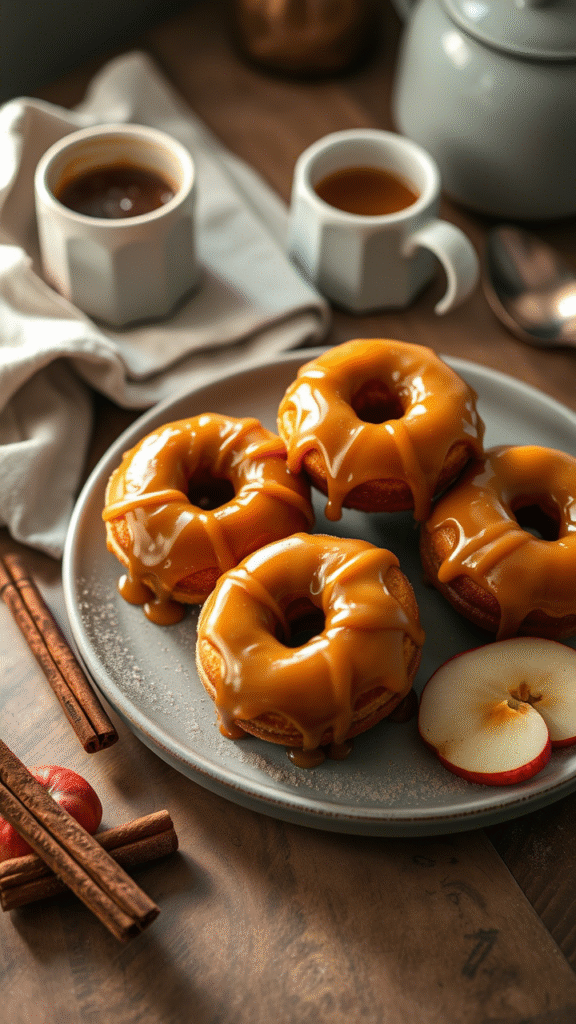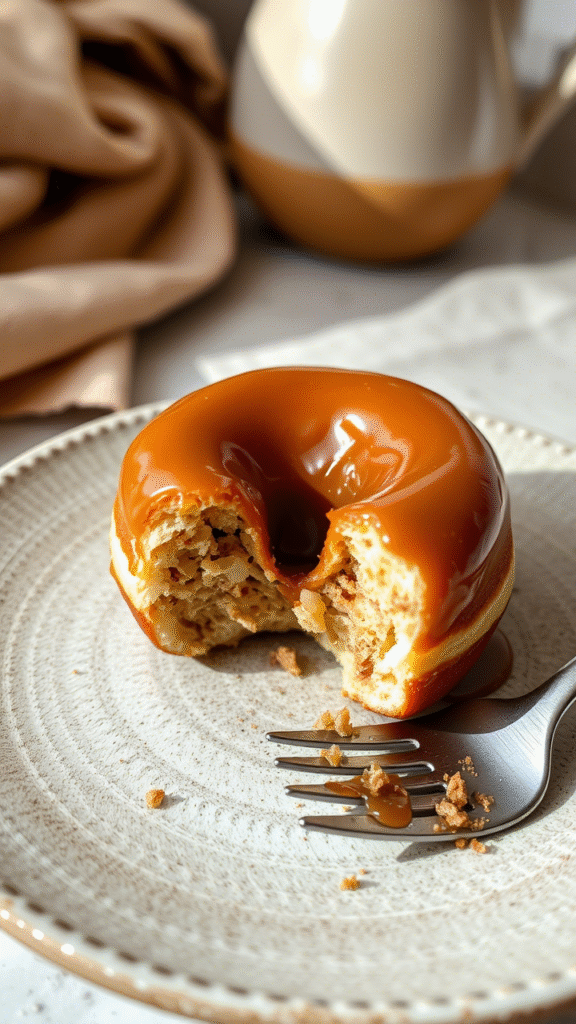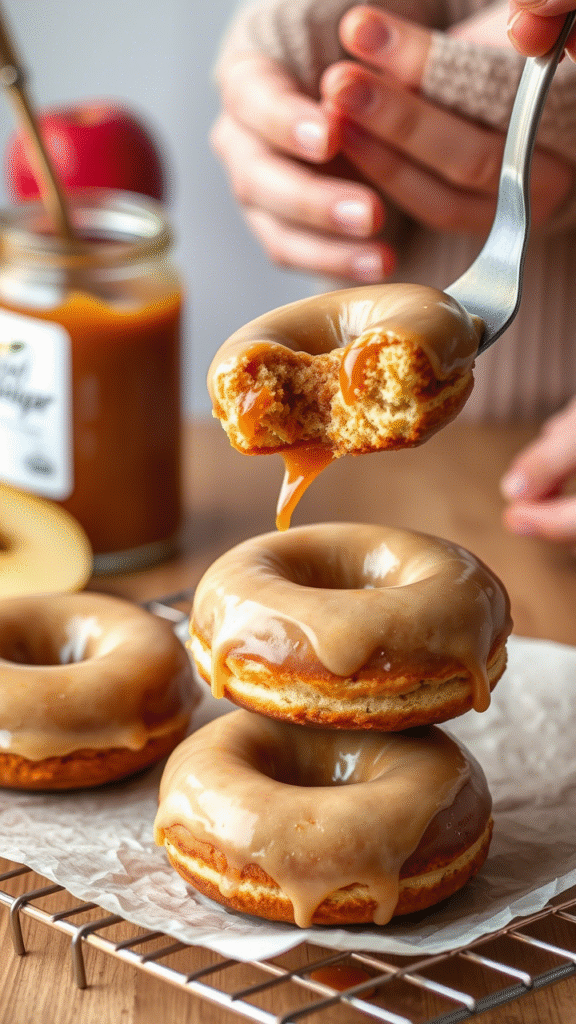Ever had that moment when a bite of something instantly whisks you back to crisp fall mornings, where the air’s a little sharp and the scent of spices dances through the kitchen? That’s exactly the magic spiced apple cider donuts bring. I still remember the first time I tasted these golden beauties at a roadside orchard stand—warm, fragrant, and just begging to be dunked in coffee. But these donuts? They’re more than just a sweet snack; they’re a symphony of seasonal flavors, traditions, and culinary technique all wrapped up in one fluffy circle.
So, what makes these spiced apple cider donuts with caramel glaze stand out? It’s the perfect balance of tart apple cider infused into the dough, kissed by a blend of warming spices—think cinnamon, nutmeg, and a whisper of clove. And that caramel glaze? It’s not just a sugary coat; it’s a luscious, buttery finish that adds depth and sticky sweetness, creating a textural and flavor contrast that’ll make you swoon. If you’re a pro baker or an enthusiast looking to elevate your donut game, read on—there’s a lot here to unpack.
Ingredients & Substitutions: Choosing the Best for Flavor and Texture

First up, the ingredients. You want to keep them straightforward but premium—quality shines through in every bite. Here’s what you’ll need:
- Apple cider (fresh, preferably unfiltered for maximum flavor)
- All-purpose flour (the backbone of the donut)
- Granulated sugar (for sweetness, balanced not to overpower)
- Baking powder and baking soda (leavening agents for perfect rise)
- Ground cinnamon, nutmeg, and ground cloves (spice trio for warmth)
- Salt (to enhance flavor)
- Eggs (for structure and moisture)
- Whole milk or buttermilk (for tang and tenderness)
- Unsalted butter (adds richness)
- Vanilla extract (for aromatic depth)
For the caramel glaze:
- Brown sugar (for molasses-rich sweetness)
- Heavy cream (for that creamy consistency)
- Butter (for silky smoothness)
- Vanilla extract and a pinch of sea salt
Now, some insight: fresh apple cider beats bottled hands down—there’s a vibrant acidity and natural sweetness that dried apple powders or juices just can’t match. If cider’s hard to find, a mix of fresh apple juice and a splash of apple cider vinegar can mimic that complexity.
Flour choice matters too. All-purpose is your go-to here for structure, but if you want a lighter, cakier donut, swapping part of it for cake flour reduces gluten development, yielding a softer crumb. High-protein bread flour? Skip it unless you want a chewier texture—not ideal for donuts.
Butter? Always unsalted. Salted butter can unpredictably alter the dough’s balance. And speaking of dairy, buttermilk adds a subtle tang and reacts with the soda for better rise—if you’re dairy-free, almond or oat milk mixed with a teaspoon of lemon juice can work as a substitute.
Step-by-Step Instructions: Nailing the Process Every Time
Okay, here’s where the magic happens. Follow closely.
- Reduce the apple cider. Pour about 1 cup of cider into a small saucepan and simmer gently until it’s reduced to roughly ¼ cup, thick and syrupy. This concentrates the apple flavor and avoids soggy dough. Don’t rush or you’ll burn it.
- Mix dry ingredients. In a large bowl, whisk together flour, sugar, baking powder, baking soda, salt, and spices. The spices here should be freshly ground if possible—pre-ground spices can taste flat or stale.
- Combine wet ingredients. In another bowl, beat eggs, milk, melted butter, vanilla, and the reduced cider. Make sure the butter isn’t hot or you’ll scramble the eggs.
- Bring it all together. Pour the wet mix into the dry and fold gently until just combined. Overmixing? Big no-no. It tightens gluten and makes donuts tough.
- Chill the dough briefly. This step helps the dough firm up for easier handling and better shape retention when frying or baking.
- Shape and cook. Traditionally, these are fried, but baked versions are popular too. For frying, heat oil to 350°F (175°C). Use a donut cutter or piping bag to shape the dough, then fry in batches. Flip carefully once the edges turn golden—don’t overcrowd the pan or temperature drops and greasy donuts happen.
- Drain and glaze. Let the donuts cool slightly on a rack. Then dip or drizzle with caramel glaze. The glaze should be warm but not hot—too hot, and it’ll melt off; too cool, and it won’t coat smoothly.
Common mistakes? Under-reducing the cider leaves watery dough. Overmixing stiffens donuts. And frying at wrong oil temp leads to greasy or burnt edges. Pro tip: keep a candy thermometer handy—precision matters.
For a twist, add a pinch of cayenne or ginger to the spice mix for a subtle kick.
Cooking Techniques & The Science Behind the Donut

Why reduce the apple cider? It’s not just flavor concentration. Water content affects gluten development. More liquid means wetter dough, which can slacken the structure and lead to dense, soggy donuts. Reducing cider tightens the dough matrix without losing that signature apple essence.
The leavening duo—baking powder and soda—works wonders here. Baking soda needs acid to activate; that’s where the buttermilk and cider come in. They generate carbon dioxide, helping the donuts puff up light and airy. This acid-base reaction is crucial for tender crumb.
Frying at steady 350°F ensures the outside crisps up just right before the inside cooks through. Too hot, and the crust burns before the center’s done. Too low, and donuts soak up oil like a sponge—gross.
Caramel glaze? The browning of sugar (Maillard reaction and caramelization) brings deep flavors of toffee and nuts. Adding butter and cream mellows the sharpness, making the glaze silky. A pinch of sea salt balances the sweetness and enhances complexity.
Equipment wise, a deep-fry thermometer is a must-have for control. A donut cutter ensures even size and shape—vital for uniform cooking. For the glaze, a heavy-bottomed saucepan prevents scorching.
Serving & Pairing Suggestions: Elevate the Experience

Presentation is all about showcasing those golden, spiced rounds with a glossy caramel sheen. Stack two or three on a rustic wooden board, sprinkle with a dusting of cinnamon sugar or chopped toasted pecans for crunch.
Serve fresh and warm, ideally with a steaming mug of spiced chai, apple cider, or a robust dark coffee. The bittersweet coffee cuts through the glaze’s richness, while cider doubles down on apple notes.
For a brunch spread, pair these donuts with creamy whipped mascarpone and fresh sliced apples or pears. You can also serve alongside a sharp cheddar cheese platter for a surprising sweet-savory contrast.
If you want to get fancy, drizzle with a thin ribbon of bourbon or maple syrup for an adult twist.
Conclusion
Spiced apple cider donuts with caramel glaze are a triumph of seasonality, technique, and flavor harmony. The key takeaway? It’s all in the layering: reduced cider concentrates flavor without excess moisture; balanced spices evoke warmth without cloying; precise frying yields perfect texture; and the caramel glaze crowns it with silky, sweet complexity.
For professionals, mastering this recipe means understanding each ingredient’s role and respecting the delicate chemistry at play. The real trick is in resisting the urge to rush—time and patience pay off in every bite.
Final tip: experiment with the spice blend—try star anise or cardamom for a twist. And always use quality ingredients; they transform a good donut into a memorable one.
FAQs
Q: Can I bake these donuts instead of frying?
A: Yes! Bake at 375°F for about 12-15 minutes. Texture will be cakier and less crispy, but still delicious.
Q: How do I store leftover donuts?
A: Store in an airtight container at room temp up to 2 days. Reheat briefly in oven or microwave to revive softness.
Q: Can I make the caramel glaze ahead?
A: Sure, keep it in the fridge and gently reheat before glazing. Add a splash of cream if it thickens too much.
Q: What if I don’t have apple cider?
A: Use fresh apple juice plus a splash of vinegar or lemon juice to mimic acidity. Avoid clear juice for less flavor.
Q: Any tips for gluten-free adaptation?
A: Use a 1:1 gluten-free flour blend with xanthan gum. Texture will differ slightly but still tasty.

Food lover, recipe creator & the heart behind NoshCrafters.com. Olivia shares mouthwatering, easy-to-make dishes that turn everyday meals into unforgettable bites. When she’s not experimenting in the kitchen, she’s busy plating up inspiration for home cooks everywhere.